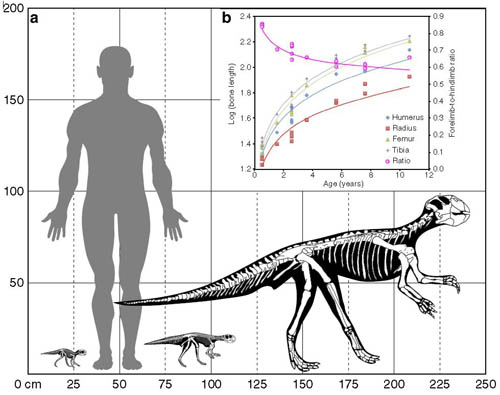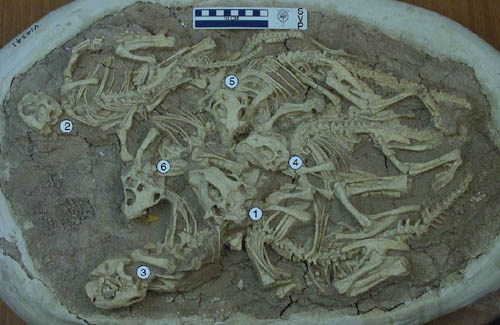Tracking the growth of dinosaurs and how they changed as they grew is difficult. Using a combination of biomechanical analysis and bone histology, palaeontologists from Beijing, Bristol, and Bonn have shown how one of the best-known dinosaurs switched from four feet to two as it grew.
Psittacosaurus, the ‘parrot dinosaur’ is known from more than 1000 specimens from the Cretaceous, 100 million years ago, of China and other parts of east Asia. As part of his PhD thesis at the University of Bristol, ZHAO Qi, Institute of Vertebrate Paleontology and Paleoanthropology (IVPP), Chinese Academy of Sciences, carried out the intricate study on bones of babies, juveniles and adults.
Dr Zhao said: "Some of the bones from baby
Psittacosaurus were only a few millimetres across, so I had to handle them extremely carefully to be able to make useful bone sections. I also had to be sure to cause as little damage to these valuable specimens as possible." Zhao sectioned two arm and two leg bones from 16 individual dinosaurs, ranging in age from less than one year to 10 years old, or fully-grown. He did the intricate sectioning work in a special palaeohistology laboratory in Bonn, Germany.
The forelimb of
Psittacosaurus is strongly negatively allometric relative to the hindlimb, and patterns of vascular canal orientation provide evidence that growth of the hindlimb was particularly rapid during the middle part of ontogeny. Histology also makes it possible to determine the ontogenetic ages of individual specimens, showing that the forelimb-to-hindlimb ratio changed rapidly during the first or second year of life and thereafter decreased gradually.
The one-year-olds had long arms and short legs, and scuttled about on all fours soon after hatching. The bone sections showed that the arm bones were growing fastest when the animals were ages one to three years. Then, from four to six years, arm growth slowed down, and the leg bones showed a massive growth spurt, meaning they ended up twice as long as the arms, necessary for an animal that stood up on its hind legs as an adult.
"This remarkable study, the first of its kind, shows how much information is locked in the bones of dinosaurs. We are delighted the study worked so well, and see many ways to use the new methods to understand even more about the astonishing lives of the dinosaurs", said study coauthor Professor XU Xing of the IVPP, one of Dr Zhao’s thesis supervisors.
"These kinds of studies can also throw light on the evolution of a dinosaur like
Psittacosaurus. Having four-legged babies and juveniles suggests that at some time in their ancestry, both juveniles and adults were also four-legged, and Psittacosaurus and dinosaurs in general became secondarily bipedal", said Professor Mike Benton of the University of Bristol, Dr. Zhao’s other PhD supervisor.
The paper was published June 28 in Nature Communications.

Fig.1 Skeletal reconstructions of hatchling, juvenile and adult individuals (left to right) showing inferred postural change, from quadrupedal to bipedal, with 178-cm-tall man for scale. (Image by IVPP)

Fig.2 Cluster of six juvenile
Psittacosaurus lujiatunensis (IVPP V14341) from the Lower Cretaceous of China. Bone histology indicates that specimens 2–6 were 2 years old at time of death, whereas specimen 1 was 3 years old. (Image by IVPP)

